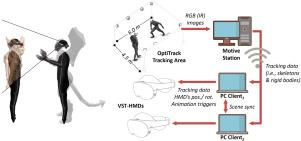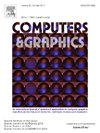Supporting motion-capture acting with collaborative Mixed Reality
IF 2.5
4区 计算机科学
Q2 COMPUTER SCIENCE, SOFTWARE ENGINEERING
引用次数: 0
Abstract
Technologies such as chroma-key, LED walls, motion capture (mocap), 3D visual storyboards, and simulcams are revolutionizing how films featuring visual effects are produced. Despite their popularity, these technologies have introduced new challenges for actors. An increased workload is faced when digital characters are animated via mocap, since actors are requested to use their imagination to envision what characters see and do on set. This work investigates how Mixed Reality (MR) technology can support actors during mocap sessions by presenting a collaborative MR system named CoMR-MoCap, which allows actors to rehearse scenes by overlaying digital contents onto the real set. Using a Video See-Through Head Mounted Display (VST-HMD), actors can see digital representations of performers in mocap suits and digital scene contents in real time. The system supports collaboration, enabling multiple actors to wear both mocap suits to animate digital characters and VST-HMDs to visualize the digital contents. A user study involving 24 participants compared CoMR-MoCap to the traditional method using physical props and visual cues. The results showed that CoMR-MoCap significantly improved actors’ ability to position themselves and direct their gaze, and it offered advantages in terms of usability, spatial and social presence, embodiment, and perceived effectiveness over the traditional method.

利用协作式混合现实支持动作捕捉表演
色键、LED 墙、动作捕捉(mocap)、三维视觉故事板和模拟摄像机等技术正在彻底改变以视觉效果为特色的电影制作方式。尽管这些技术很受欢迎,但也给演员带来了新的挑战。当通过 mocap 制作数字角色动画时,演员的工作量会增加,因为他们需要发挥想象力来设想角色在片场的所见所闻。本作品通过展示一个名为 CoMR-MoCap 的协作式 MR 系统,研究了混合现实(MR)技术如何在 mocap 过程中为演员提供支持。通过使用视频透视头戴式显示器(VST-HMD),演员可以实时看到穿着 mocap 服的演员的数字表现和数字场景内容。该系统支持协作,使多名演员既能穿上 mocap 套装为数字角色制作动画,又能佩戴 VST-HMD 将数字内容可视化。一项有 24 人参与的用户研究将 CoMR-MoCap 与使用实物道具和视觉提示的传统方法进行了比较。结果表明,CoMR-MoCap 显著提高了演员定位和引导视线的能力,与传统方法相比,它在可用性、空间和社交存在感、体现和感知效果方面更具优势。
本文章由计算机程序翻译,如有差异,请以英文原文为准。
求助全文
约1分钟内获得全文
求助全文
来源期刊

Computers & Graphics-Uk
工程技术-计算机:软件工程
CiteScore
5.30
自引率
12.00%
发文量
173
审稿时长
38 days
期刊介绍:
Computers & Graphics is dedicated to disseminate information on research and applications of computer graphics (CG) techniques. The journal encourages articles on:
1. Research and applications of interactive computer graphics. We are particularly interested in novel interaction techniques and applications of CG to problem domains.
2. State-of-the-art papers on late-breaking, cutting-edge research on CG.
3. Information on innovative uses of graphics principles and technologies.
4. Tutorial papers on both teaching CG principles and innovative uses of CG in education.
 求助内容:
求助内容: 应助结果提醒方式:
应助结果提醒方式:


